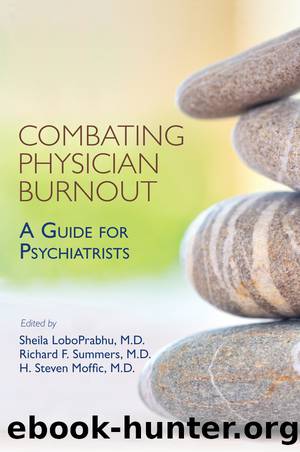Combating Physician Burnout by LoboPrabhu Sheila;Summers Richard F.;Moffic H. Steven;

Author:LoboPrabhu, Sheila;Summers, Richard F.;Moffic, H. Steven;
Language: eng
Format: epub
Publisher: American Psychiatric Association Publishing
Published: 2019-08-15T00:00:00+00:00
SPECIFIC STUDIES ON THE ELECTRONIC HEALTH RECORD AND PHYSICIAN RESPONSES
In 2014, Babbott and colleagues analyzed the relationship between EHR functionality levels and burnout. They identified three levels of EHR functionality (low, moderate, and high) based on the number of EHR functions available. Compared with the low-functionality group, there were higher stress and lower satisfaction scores among the moderate group. Physicians in the high-functionality group reported lower satisfaction compared with the low-functionality group. For the time pressure measure (time needed/time scheduled), only the high-functionality group reported time pressure associated with more burnout, dissatisfaction, and intent to leave practice. These findings suggest that 1) as EHRs gain functionality levels and become more complex, physician stress will increase and job satisfaction will decrease, and 2) for EHRs with moderate numbers of functions, physicians may rely on paper or other systems that add to time and administrative burdens.
In 2013, Friedberg and colleagues addressed factors affecting physician satisfaction. Regarding EHRs, physicians liked the remote access to patient information and that EHRs show the potential to improve care. However, physicians faced a number of challenges: poor EHR usability, time-consuming data entry, interference with face-to-face patient care, inefficient and less fulfilling work content, inability to exchange health information between EHR products, degradation of clinical documentation (specifically, using templated notes), and the high costs of implementation.
Shanafelt et al. (2016) assessed EHR use and the relationship between physician burnout and job satisfaction. The mean responses for physicians who used EHRs showed that only 36% were satisfied or very satisfied, with approximately 33% of psychiatrists noting this level of satisfaction. Regarding the same satisfaction measures for clerical burden, the mean was only 37% of physicians (43% of psychiatrists). Those physicians who used patient portals, EHRs, and computerized physician order entry (CPOE) had lower satisfaction with clerical burden and higher rates of burnout. In a multivariable analysis, physicians using CPOE had approximately 30% higher risk of burnout after adjusting for other factors. Shanafelt et al. (2016, p. 844) concluded, âPhysicians who used EHRs or CPOE were at higher risk for burnout regardless of whether they were or were not satisfied with their EHR or CPOE.â
Download
This site does not store any files on its server. We only index and link to content provided by other sites. Please contact the content providers to delete copyright contents if any and email us, we'll remove relevant links or contents immediately.
The Elements by Theodore Gray(2448)
Designing Your Life by Bill Burnett(2284)
The Meaning of it All by Richard Feynman(1915)
The Chimp Paradox by Peters Dr Steve(1871)
Why Is God Laughing?: The Path to Joy and Spiritual Optimism by Deepak Chopra(1840)
Tiny Habits by BJ Fogg(1453)
Women in Science by Rachel Ignotofsky(1412)
Cosmos by Carl Sagan(1406)
Vaccine Epidemic by Louise Kuo Habakus(1323)
Predation ID Manual by Kurt Alt(1316)
You're Not Listening by Kate Murphy(1181)
The Science of Why by Jay Ingram(1064)
The Dragons of Eden: Speculations on the Evolution of Human Intelligence by Carl Sagan(1011)
The Courage to Be Happy by Ichiro Kishimi & Fumitake Koga(1009)
The Science of Superheroes by Mark Brake(1008)
The Double Helix (1968) by 11. James D. Watson(944)
0345315367 by Carl Sagan(920)
The Science of Why 2 by Jay Ingram(918)
Dragons of Eden by Carl Sagan(900)
